
Keen to stand on its own feet and produce decent investible surpluses, Indian Railways has embarked on a multi-pronged plan to boost revenues. While the heavily subsidised passenger segment will see creeping tariff hikes from September under a diktat from the Prime Minister’s Office, the transporter has also lined up a slew of long-term freight contracts with large customers like cement and steel firms. Worried over the stagnant growth in freight loading — in FY17, the loading actually declined an annual 0.6% — and the loss of consumers to roads and airlines, the railways thinks that contracts of three years or more will help create a loyal base of large freight users.
While some long-term freight contracts will be signed on Thursday, a clutch of steps taken in recent months like launch of “time-tabled” freight trains and double-decked dwarf containers, waiver of port congestion charges and dual tariff policy for iron ore are also expected to boost loading and freight revenue.
According to official sources, the three-year freight contracts will provide for fixed rates for the contract period, which will be topped with discounts from the second year onwards if loading levels are retained. The discounts on incremental traffic may go up to 35%.
“Two cement manufacturers and one steel firm have already come on board and another 10 are in the pipeline (for signing the long-term contracts). The deals are getting finalised across different zones,” said a top railway official, requesting not to be identified.
Despite a 0.4% drop in industrial production and 8.7% contraction in cement output in December, mostly on the back of demonetisation, the railways’ freight loading has shown an encouraging trend since January. During the first quarter of the current fiscal, the railways revenue from freight has increased 12% compared with the same period last year.
The freight loading target for the current fiscal is 1,165 million tonnes (mt) against 1,094 mt last year. The railways’ operating ratio had worsened to 95 in FY17 from 90.5 in FY16. Mindful of the market realities, the OR target set for the current year is almost the same as last year’s.
Earnings from freight are estimated to contribute 62% of the transporter’s gross traffic receipts in FY18, against 66% in FY16, in what reflects the gradual roll-back of subsidies in the passenger segment. All segments on the passenger side except the air-conditioned 3-tier category are still making losses.
The signing of the long-term freight contracts comes at a time when the PMO has asked the carrier to redirect 20 mt of freight traffic from roads to the railways by the end of this financial year. “We have to provide a very competitive transportation system vis-a-vis the roads which is also witnessing huge investments. The average parcel size is decreasing, which make them suitable for transport by road. Definitely there are challenges and that is why we have tried many alternatives such as time-tabled freight trains to attract traffic,” added the official quoted above.
The railways has been constantly losing freight traffic to roads; the transporter’s share in freight volume has fallen from around 90% in 1950 to just 30% at present.
